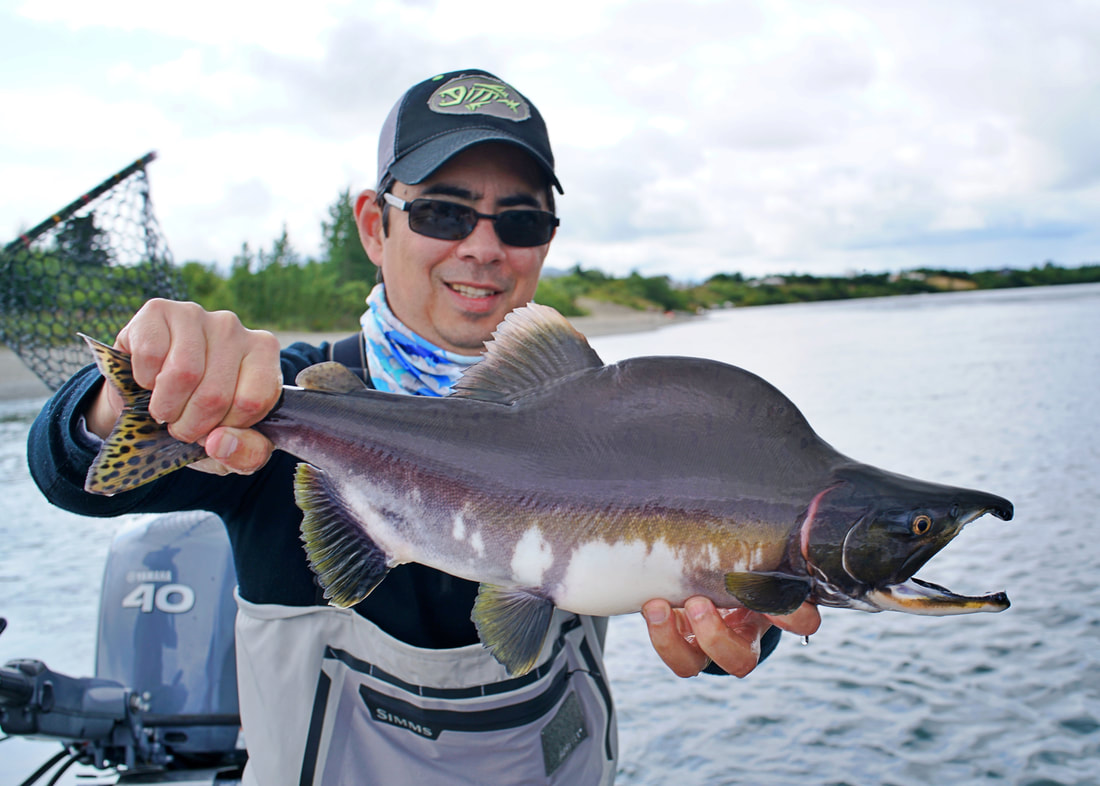Pink Salmon
Oncorhynchus gorbuscha
HOME
Other Species
Pink Salmon Description
Pink Salmon, also known as Humpback Salmon, are one of the five species of Pacific Salmon. They are found on both sides of the Pacific, in Alaska and the Pacific Northwest area of North America as well as on the other side in Japan and Russia. They are the smallest of the Pacific Salmon.
Like all Pacific Salmon, Pinks are born in streams and then out to sea. There they stay for about 18 months before returning back to their native streams to spawn. In some streams they are so numerous that it almost looks like you could walk across their backs. They have the shortest life cycle of all Pacific Salmon.
Like all Pacific Salmon, Pinks undergo significant physical changes upon re-entering freshwater. They stop feeding, but can still be caught due to their instinct to attack things that go by. They turn pink in color, and the males get prominent hooked jaws. Their flesh becomes less appetizing at this point, so if you plan to eat them you are better off catching them when they are still in the ocean or when they have just entered fresh water and are still silver.
After making a nest in shallow water called a redd, the female lays her eggs and the male fertilizes them. After spawning, the salmon slowly die.
Pinks are aggressive feeders and readily take spoons, spinners, and flies. Once hooked, they often leap into the air to try to throw the hook. Cohos average about 3-5 lbs as adults and top out around 14lbs.
Pink Salmon Pound for Pound Fight Rating - 6 out of 10 on the Saltwater Scale
Pinks pull relatively hard for their size, but unfortunately they do not get very big.
Pink Salmon Culinary Rating - Low
Pink Salmon caught in the ocean are ok to eat, especially if smoked. Once they enter fresh water, the quality of their meat deteriorates quickly.
Pink Salmon Tackle
A medium action spinning rod or 6 weight fly rod will handle most if not all Pinks. Monofilament line is often a better option than braid in many cases as they have fairly soft mouths and the stretch of mono results in less pulled hooks. However, either will work. 12lb line should be able to handle pretty much any Pink, although trollers often use heavier lines because they are trolling heavier outfits.
Pink Salmon Techniques
When they are still in the ocean, the key to fishing for Pinks is to find the baitfish they are feeding on, which are typically herring. These are often found near current rips that concentrate zooplankton for them to eat. The Pinks will be near the herring. Good electronic fish finders are a big help here, although sometimes the herring are on the surface and can be spotted by looking for puddling fish or diving birds. Once located, you can troll or mooch or jig for them with lures or bait. People often use shiny dodgers or flashers to get their attention, although those typically dampen the fight if you hook one.
Once Pinks come in the rivers to spawn, you can look for them in calmer water where they congregate before continuing to push up the rivers to their spawning beds. Once they start spawning, they are occasionally incidentally hooked but generally not sought after.
Pink Salmon Lures
In the ocean, you can cast, jig, or troll for them using small shiny spoons such as the Pixie or spinners. Pink or Orange are good colors. A downrigger may be necessary if the fish are down deep and spread out. Trolling with shiny bucktail flies or hoochies is very popular and effective, although personally I would always rather cast or jig for them.
In the rivers, small pink spoons or spinners can be dynamite. They are not feeding in the rivers, but often strike at bright things out of aggression. Pink seems to be the color that fires them up the most.
In the rivers, fly fishing can be a fun way to catch them. Just cast out small loud and flashy pink and orange flies and strip them back.
In the ocean, you can cast, jig, or troll for them using small shiny spoons such as the Pixie or spinners. Pink or Orange are good colors. A downrigger may be necessary if the fish are down deep and spread out. Trolling with shiny bucktail flies or hoochies is very popular and effective, although personally I would always rather cast or jig for them.
In the rivers, small pink spoons or spinners can be dynamite. They are not feeding in the rivers, but often strike at bright things out of aggression. Pink seems to be the color that fires them up the most.
In the rivers, fly fishing can be a fun way to catch them. Just cast out small loud and flashy pink and orange flies and strip them back.
Pink Salmon Baits
In the ocean, cut herring are a very popular bait. These can be trolled or drifted.
Where to Catch Big Pink Salmon
Alaska and Washington have good runs of big Pink Salmon.
If you want to target them in the ocean, this is a good choice: www.pybus.com
If you have some extra cash to spend, a great place to get them in rivers on fly is www.fishasl.com
This lodge is a great place to target Pinks in Alaska in rivers: www.aniakriverlodge.com.
In the ocean, cut herring are a very popular bait. These can be trolled or drifted.
Where to Catch Big Pink Salmon
Alaska and Washington have good runs of big Pink Salmon.
If you want to target them in the ocean, this is a good choice: www.pybus.com
If you have some extra cash to spend, a great place to get them in rivers on fly is www.fishasl.com
This lodge is a great place to target Pinks in Alaska in rivers: www.aniakriverlodge.com.



